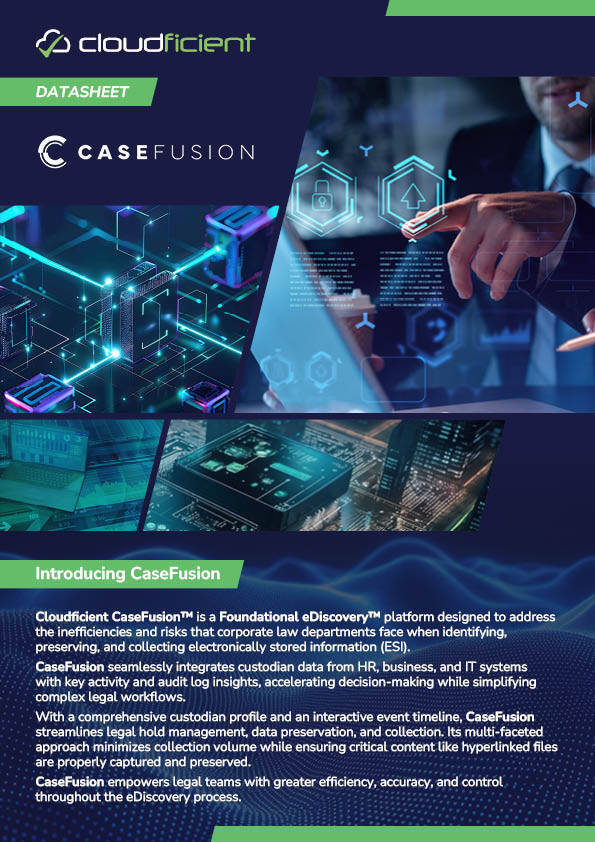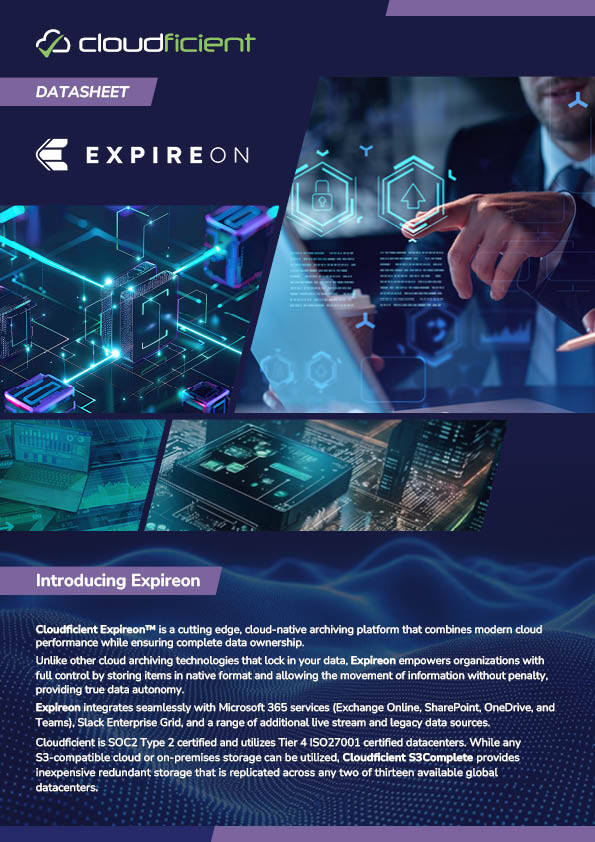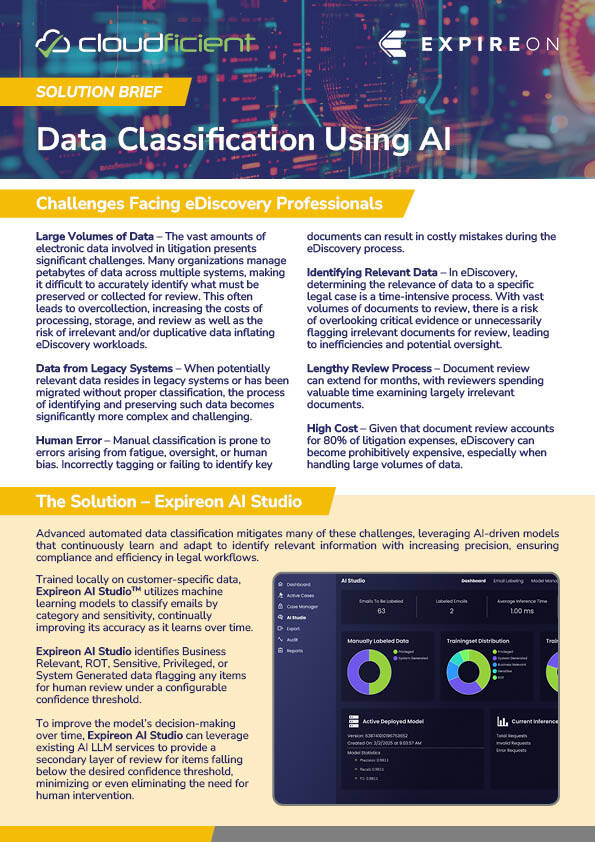- Solutions
- Information Governance
Information Governance for Enterprise Organizations
Effective information governance enables organizations to make informed decisions about what information to keep, where to store it, who can access it, and when to delete it. A comprehensive approach reduces storage costs while minimizing legal or regulatory risks.
What is Information Governance?
Information governance is the strategic framework that organizations use to manage, protect, and optimize their information assets throughout their entire lifecycle. It combines policies, processes, and technologies to ensure that data is properly classified, securely stored, retained appropriately, and disposed of in accordance with legal, regulatory, and business requirements.
Information Governance Challenges Organizations Face
Effective information governance is complicated by regulatory complexity, data growth, and platform fragmentation. Governance and compliance challenges require organizations to balance operational efficiency with regulatory obligations across multiple jurisdictions and evolving legal frameworks. Organizations that implement robust enterprise data management frameworks can reduce downstream review costs by as much as 40% by adopting intelligent data classification and early data assessment capabilities. Without integrated platforms providing unified oversight, organizations risk compromising compliance, increasing risk, and undermining operational efficiency.
Data Volume and Complexity Overwhelm Traditional IT Governance
The growth of enterprise data volumes over more tools has created challenges for traditional IT governance frameworks. Organizations now manage unstructured data across email systems, collaboration platforms, cloud storage, and legacy archives, creating a maze of requirements and compliance obligations. Traditional IT governance approaches rely on manual policy enforcement and periodic audits, and can’t keep pace with modern data creation, creating challenges with:
-
Retention policy conflicts: Different data types require varying retention periods based on legal, regulatory, and business requirements. But manual governance processes struggle to apply appropriate policies consistently across platforms, leading to over-retention that inflates review costs and legal exposure.
-
Discovery and access delays: Without proper data categorization and indexing, organizations cannot efficiently locate specific information when required, forcing manual searches across disconnected repositories.
-
Compliance verification failures: It is almost impossible to ensure that governance policies are being applied correctly when relying on manual processes. Without automating these processes, it is impossible to be certain if you are meeting regulatory obligations.
-
Resource allocation: IT and compliance teams working on data governance manually are pulled away from strategic initiatives, and ever-growing data volumes require ever-increasing infrastructure investment.


Retention Policy Enforcement and Legal Hold Coordination
Legal holds further complicate the already tangled web of retention policies across distributed systems. Manual retention processes create gaps where critical information risks being prematurely deleted or preserved indefinitely, and where legal hold notifications fail to prevent spoliation. These retention and preservation challenges create significant operational and legal risk including:
-
Automated deletion conflicting with preservation obligation: Standard retention policies trigger automatic deletion of data that may need to be preserved for legal holds, regulatory investigations, or pending litigation, and risk spoliation if they are deleted without proper coordination between departments.
-
Inconsistent retention policy application: Applying different retention schedules to various data types is difficult and time-consuming, leading to over-retention that inflates storage costs, or under-retention that creates compliance gaps.
-
Legal hold notification tracking failures: Manual custodian acknowledgement and notification tracking are not accurate enough to verify if preservation occurred and was compliant, creating defensibility concerns.
-
Hyperlinked content preservation gaps: Standard retention and legal hold systems fail to identify and preserve documents referenced in emails and chats, creating critical evidence gaps when hyperlinked materials are deleted according to different retention schedules, despite the referencing communication being on hold, undermining the completeness of preserved information.
Retention Policy Enforcement and Legal Hold Coordination
Legal holds further complicate the already tangled web of retention policies across distributed systems. Manual retention processes create gaps where critical information risks being prematurely deleted or preserved indefinitely, and where legal hold notifications fail to prevent spoliation. These retention and preservation challenges create significant operational and legal risk including:
-
Automated deletion conflicting with preservation obligation: Standard retention policies trigger automatic deletion of data that may need to be preserved for legal holds, regulatory investigations, or pending litigation, and risk spoliation if they are deleted without proper coordination between departments.
-
Inconsistent retention policy application: Applying different retention schedules to various data types is difficult and time-consuming, leading to over-retention that inflates storage costs or under-retention that creates compliance gaps.
-
Legal hold notification tracking failures: Manual custodian acknowledgement and notification tracking are not accurate enough to verify if preservation occurred and was compliant, creating defensibility concerns.
-
Hyperlinked content preservation gaps: Standard retention and legal hold systems fail to identify and preserve documents referenced in emails and chats, creating critical evidence gaps when hyperlinked materials are deleted according to different retention schedules, despite the referencing communication being on hold, undermining the completeness of preserved information.


Scattered Communication and Collaboration Data
Teams, Slack, email, and other collaboration tools all isolate business-critical communications, complicating archiving and compliance efforts. Without comprehensive strategies and tools that span all communication platforms, organizations struggle with incomplete eDiscovery collections, missing evidence relationships, and costly manual processes. This fracture creates significant operational and legal risks, including:
-
Communication platform silos: Critical conversations are scattered across disconnected messaging systems preventing comprehensive audit trails, compliance timeline reconstruction during legal matters, and creating gaps in regulatory compliance oversight.
-
Hyperlinked content preservation failures: Standard archiving approaches fail to capture referenced documents, embedded files, and hyperlinked materials at the time they were accessed, creating critical evidence gaps when linked content changes or is deleted according to different retention policies.
-
Shadow IT proliferation: Unapproved communication platforms adopted by employees create ungoverned data repositories, undermining compliance efforts and creating collection gaps that surface during regulatory audits or legal investigations.
-
Real-time preservation challenges: Traditional archiving systems cannot capture communications and referenced materials in real-time, allowing critical evidence to be modified or deleted before preservation occurs, creating defensibility concerns.
Scattered Communication and Collaboration Data
Teams, Slack, email, and other collaboration tools all isolate business-critical communications, complicating archiving and compliance efforts. Without comprehensive strategies and tools that span all communication platforms, organizations struggle with incomplete eDiscovery collections, missing evidence relationships, and costly manual processes. This fracture creates significant operational and legal risks, including:
-
Communication platform silos: Critical conversations are scattered across disconnected messaging systems, preventing comprehensive audit trails, compliance timeline reconstruction during legal matters, and creating gaps in regulatory compliance oversight.
-
Hyperlinked content preservation failures: Standard archiving approaches fail to capture referenced documents, embedded files, and hyperlinked materials at the time they were accessed, creating critical evidence gaps when linked content changes or is deleted according to different retention policies.
-
Shadow IT proliferation: Unapproved communication platforms adopted by employees create ungoverned data repositories, undermining compliance efforts and creating collection gaps that surface during regulatory audits or legal investigations.
-
Real-time preservation challenges: Traditional archiving systems cannot capture communications and referenced materials in real-time, allowing critical evidence to be modified or deleted before preservation occurs, creating defensibility concerns.


Employee Lifecycle and Access Management Complexities
Remote work, contractors, and role changes create challenges in maintaining appropriate data access while ensuring organizational information security. Difficulty implementing consistent governance while maintaining operational efficiency and regulatory compliance can create significant enterprise data management challenges with:
-
Onboarding delays: Manual processes delay new employees’ productivity while temporary access arrangements create security gaps that can become permanent.
-
Role change complications: Employee promotions, transfers, and department changes require complex access modifications that are often handled manually, creating inconsistency.
-
Offboarding failures: Departing employees often retain system access after termination, creating security risks and raising the potential for intellectual property theft and regulatory violations.
-
Data custody confusion: Employee role changes and departures create unclear data ownership, making it difficult to identify custodians during legal matters or compliance audits, complicating governance and preservation obligations.
How to use Information Governance to Improve Enterprise Data Management
To achieve sustainable eDiscovery success and maintain a competitive advantage, organizations must implement comprehensive best practices that address the most common challenges in eDiscovery management and ensure compliance with evolving legal requirements.
Develop a Strategic Governance and Compliance Framework
Deploy integrated platforms that unify data across HR, IT, and business system silos to provide comprehensive visibility into information assets across your whole environment. Select technologies that integrate with your applications, collaboration platforms, and legacy systems to reduce risk while maintaining enterprise data management standards.
Modern frameworks should incorporate automated hyperlinked document preservation that captures referenced materials at the time communications were sent to ensure complete context preservation later. Organizations benefit from adopting systems that automate policy enforcement and maintain complete audit trails to maintain compliance across distributed environments.
Technology Integration and Platform Unification
Your governance tool should scale across siloed systems to provide visibility into information access across distributed environments. Select technology that integrates seamlessly with your enterprise applications, including Microsoft 365, collaboration platforms, and legacy systems, to improve IT risk management.
Content should be captured from across all platforms, including communications from Teams, Slack, email, and other tools in a single repository that can also automatically preserve hyperlinked files and embedded documents to prevent evidence gaps. Organizations benefit from platforms that combine powerful automation features with easy-to-use interfaces to maximize efficiency while providing export flexibility in a standard format.
Automated Classification and Policy Enforcement
Implement intelligent classification systems that automatically analyze content, context, and metadata to ensure consistent policy application across information assets while reducing manual review requirements. Deploy AI-enhanced categorization that identifies sensitive information, business records, and retention-eligible content accurately while maintaining complete audit trails.
Advanced classification systems should be utilized to reduce manual classification efforts, while allowing effective filtering of data to reduce review volumes and enable early identification of relevant content. Automation is essential to ensure policy enforcement remains effective and current with business needs.
IT Risk Management and Monitoring
Establish comprehensive IT risk management protocols that provide complete audit trails throughout information’s lifecycle. Robust monitoring frameworks track policy enforcement across all of your applications, identify compliance gaps in real-time, and generate detailed reports for audits or regulatory purposes.
IT governance strategies must include rapid preservation to reduce your trigger-to-hold time. Governance solutions should maintain defensibility while providing comprehensive audit capabilities and enabling collaboration between compliance, legal, and IT teams.
Cross-Functional Team Coordination
Breaking down walls between legal, IT, HR, and business units ensures efficient policy implementation while maintaining operational effectiveness. Deploy a system that consolidates custodian data, system information, and business context to enable seamless communication between stakeholders from a single platform. Effective enterprise data management requires a platform that can integrate across your applications. Effective tools provide real-time visibility into data status, custodian mapping, and enable identification.
IT Risk Management and Monitoring
Establish comprehensive IT risk management protocols that provide complete audit trails throughout the information lifecycle. Robust monitoring frameworks track policy enforcement across all of your applications, identify compliance gaps in real-time, and generate detailed reports for audits or regulatory purposes.
IT governance strategies must include rapid preservation to reduce your trigger-to-hold time. Governance solutions should maintain defensibility while providing comprehensive audit capabilities and enabling collaboration between compliance, legal, and IT teams.
AI Data Categorization
Organizations struggle with massive data volumes and manual classification processes that create manual review bottlenecks, inconsistent categorization standards, and expensive over-collection practices. Implementing AI-powered data categorization addresses these critical gaps by deploying machine learning models that can learn from your organization's communication patterns to reduce downstream review volumes by up to 33%.
Data Retention & Compliance
Enterprises are exposed to regulatory violations, and risk not preserving evidence due to fragmented data retention policies. Implementing comprehensive data retention and compliance solutions addresses these critical gaps by automating policy enforcement, preserving hyperlinked documents, and content classification. Effective retention strategies reduce storage costs while ensuring business-critical information remains accessible.
Collaboration & Communication Archiving
Business communications scattered across Microsoft 365, Slack, Teams, and collaboration platforms create isolated data that fragments business context and increases compliance risk. Traditional archiving approaches fail to capture the relationships between communications and referenced documents, creating evidence gaps when hyperlinked materials change or are deleted. Organizations should seek to consolidate data from multiple platforms into a single repository to streamline discovery.
Legacy Data Management
Legacy system dependencies leave organizations trapped with escalating costs, security vulnerabilities, and compliance failures while their information remains locked in proprietary formats. Implementing comprehensive legacy data management solutions addresses these gaps by enabling secure migration to cloud-native platforms, eliminating vendor lock-in, and providing complete data ownership.
Employee Offboarding
Organizational changes over time expose organizations to spoliation risks and escalating licensing costs. Implementing comprehensive employee offboarding solutions addresses these gaps by automating offboarding procedures, data classification, and other unnecessary workflows to lower costs and improve efficiency by eliminating per-user licensing costs, preserving hyperlinked documents, and enabling rapid preservation to prevent spoliation.
Our Solutions
Cloudficient delivers information governance solutions that eliminate data silos, reduce compliance risks, and dramatically lower costs through AI-powered classification, automated workflows, and cloud-native architecture. Our governance and compliance platforms provide complete data ownership without vendor lock-in while automating IT governance processes in a defensible manner across systems.
Expireon: Cloud Native Archiving with Complete Data Ownership
Expireon delivers the performance and scalability of the cloud while giving you full control over your data. Unlike legacy platforms, which charge export fees as high as $9,500 per terabyte or lock you into proprietary ecosystems, Expireon allows you to retain ownership of data, and uses capacity-based pricing to eliminate licensing costs for departed employees.
Expireon integrates natively with Microsoft 365 (Exchange, SharePoint, OneDrive, and Teams), Slack, and over 300 other tools to seamlessly ingest data, even from acquired companies. The platform automatically preserves hyperlinked documents embedded in messages and retrieves the closest-in-time version to ensure audit-ready access during litigation or investigations, reducing downstream review costs by about 40%. Expireon provides a home for data unsuitable for Purview and exports data in RSMF format to integrate with your review tool.
Expireon AI Studio: AI That Learns on Your Data to Reduce Review Costs
Expireon AI Studio leverages machine learning trained on your organization’s communication patterns and business context. AI Studio operates within your security boundaries and continuously improves its ability to classify content by type, business value, and sensitivity.
It automatically identifies and categorizes emails as Business Relevant, ROT, Sensitive, Privileged, or System Generated. Initial training on synthetic and limited live data results in confidence levels over 90%, with better results as more content is processed over time. By prioritizing the most relevant content and filtering low-value data early, AI Studio helps legal teams achieve 30-40% reduction in review volumes, translating to meaningful cost savings and faster case resolution.
CaseFusion: Unified Identification, Preservation, and Collection Platform
CaseFusion revolutionizes information governance by integrating identification, preservation, and collection workflows into a single unified platform that eliminates fragmented processes that create blind spots. CaseFusion unified information from HR, IT, and over 300 other sources to build complete pictures of custodians and their data relationships.
The platform reduces downstream review data by 60-80% through intelligent custodian targeting while reducing collected data volumes by 40-50% by filtering irrelevant content before it enters expensive review workflows. CaseFusion reduces trigger-to-preservation time from 72-96 hours to under 24 hours, ensuring rapid compliance with legal hold requirements and preventing spoliation during time-sensitive matters. CaseFusion eliminates spreadsheet-driven workflows by automating everything from custodian interviews and legal holds to in-place preservation and targeted collection with the ability to collect hyperlinked files with full visibility into version history.
Frequently Asked Questions
What is information technology governance?
Information technology governance refers to the leadership, organizational structures, and processes that ensure an organization's information technology supports and enables business strategies and objectives.
Why is IT governance?
IT governance is the leadership framework and organizational processes that ensure information technology supports business strategies and objectives. It includes decision-making authority for technology investments, risk management protocols, compliance oversight, and accountability structures that balance IT opportunities with organizational risks while meeting regulatory requirements and industry standards.
Why is information governance important?
Information governance is important because it enables organizations to manage data growth while reducing compliance risks, controlling storage costs, and maintaining defensibility during legal matters. Effective information governance frameworks prevent regulatory penalties, reduce eDiscovery expenses, and ensure that business-critical information remains accessible when needed while sensitive data is appropriately protected.
What is information security governance?
Information security governance is the system of policies, procedures, and controls that organizations implement to protect information assets from unauthorized access, breaches, and cyber threats. It encompasses risk assessment frameworks, access control protocols, encryption standards, and incident response procedures that ensure sensitive data receives appropriate protection while enabling authorized users to access information necessary for business operations and regulatory compliance.
How do hyperlinks complicate eDiscovery?
Traditional eDiscovery workflows were built to handle static attachments, not dynamic files. Content that can change over time needs to be captured contemporaneously so that the version “as sent” is preserved. Missing hyperlinked content creates evidence gaps that can be discovered during review, leading to costly supplemental productions and potential discovery disputes.
.png?width=620&height=82&name=Untitled%20design%20(18).png)
.png?width=600&height=79&name=Untitled%20design%20(18).png)
-3.png?width=250&height=33&name=Untitled%20design%20(18)-3.png)





